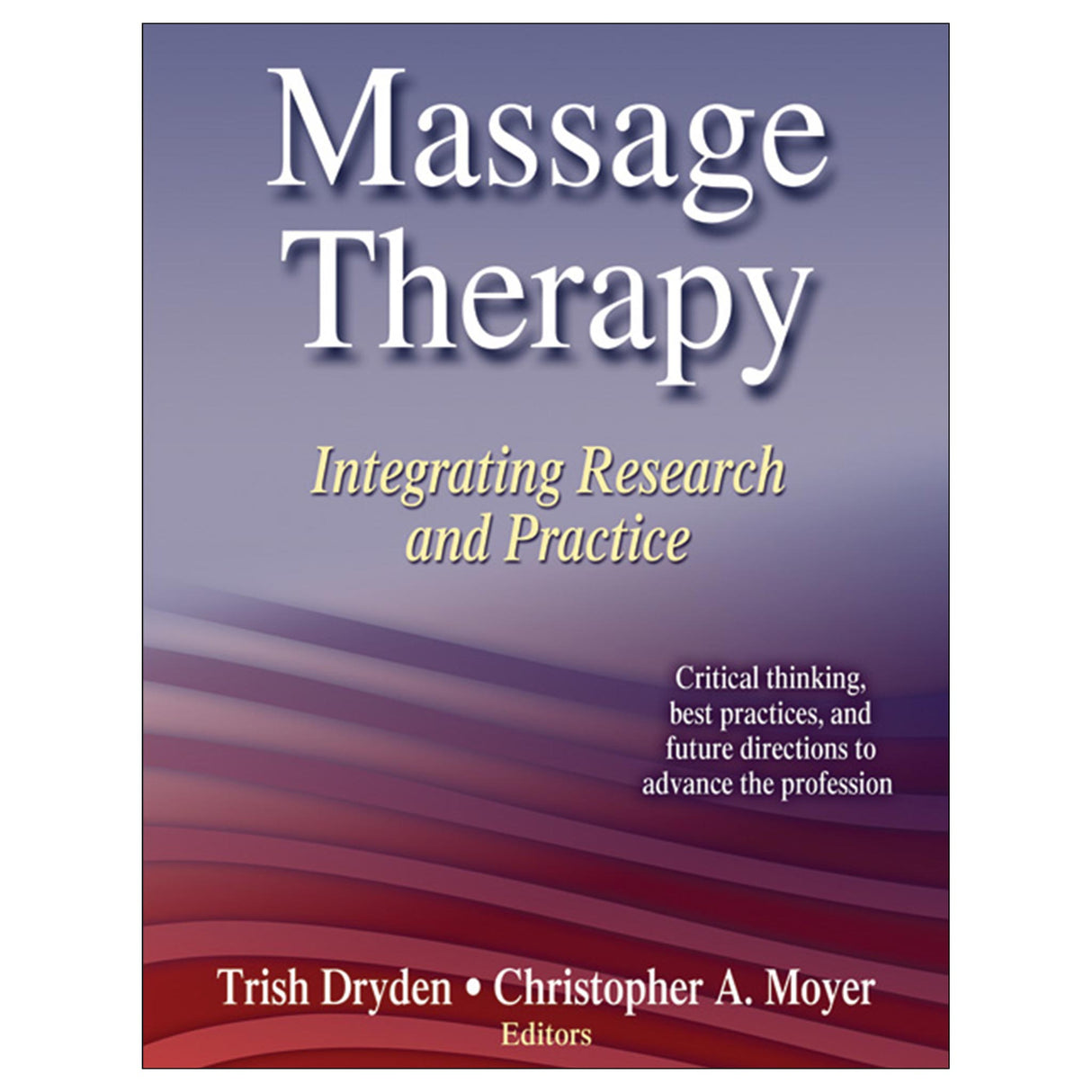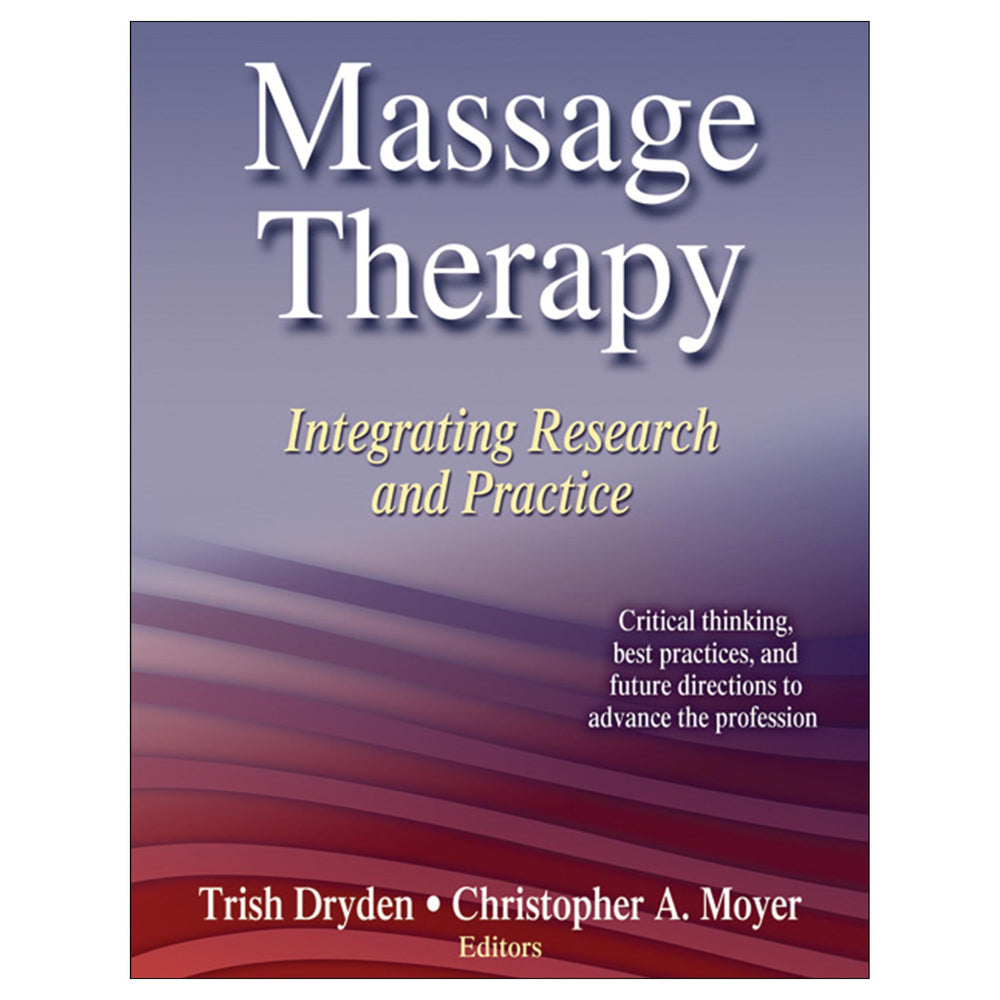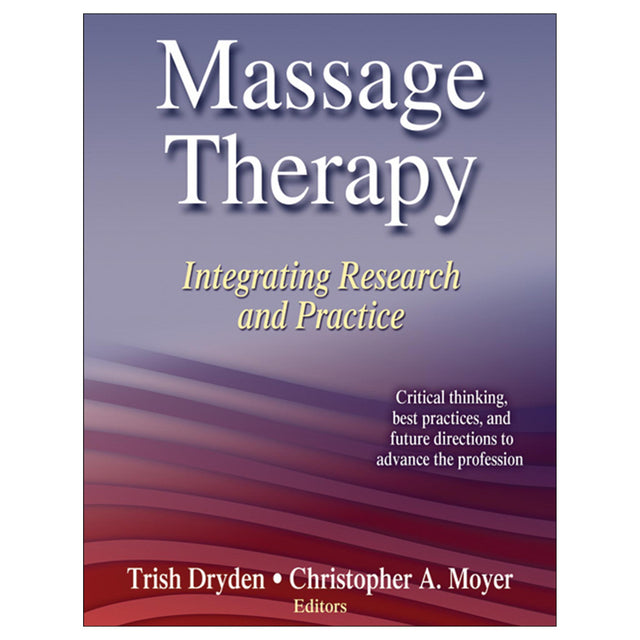Massage Therapy PDF
Integrating Research and Practice
Author: Trish Dryden, Christopher A. Moyer
$57.00 USD
Access Duration: 10 Years
Massage Therapy: Integrating Research and Practice presents the latest research examining the evidence for the use of various massage therapy techniques in treating pathological conditions and special populations. In this resource readers will find a synthesis of information from the diverse fields of kinesiology, medicine, nursing, physical therapy, and psychology.
Authored by experts carefully selected for their specific knowledge, experience, and research acumen, Massage Therapy: Integrating Research and Practice will assist both students and practitioners in these areas:
• Learning the benefits of evidence-based massage therapy practice
• Understanding various research methods
• Developing research skills by learning guidelines for writing case reports and journal articles
• Understanding how to integrate massage therapy research into education and clinical practice
This text presents a seamless integration of research and practice in four parts, providing readers first with a background to the field of massage therapy followed by discussion of research methods. Next is an evidence-based presentation of the efficacy of massage therapy for conditions and populations often encountered in massage therapy practice. This clinicial section presents three patient populations (pediatric, athletic, and elderly); three pain-related types (headache, neck and shoulder pain, and low back pain); and six conditions that massage therapists may encounter: pregnancy and labor, scar treatment, cancer, fibromyalgia, anxiety and depression, and clients who have experienced sexual trauma. Recommendations and evidence-based treatment guidelines are clearly defined for each condition. Case reports developed from real-life cases are included in this section, offering readers a real-world context for the clinical content presented.
The final section illustrates specific ways to integrate research into the educational and professional development of current and future massage therapists. It provides readers with the fundamental tools for a research-based approach in clinical practice, especially as it relates to special populations. A running glossary, chapter summaries, and critical thinking questions assist students in learning the content and act as self-study tools for practitioners.
Massage Therapy: Integrating Research and Practice offers both students and practitioners of massage therapy the most current evidence-based information, guidelines, and recommendations for the treatment of conditions often seen in massage therapy practice. This essential reference will assist practitioners in understanding the scientific literature and its application in enhancing the practice of this safe and effective health intervention.
Part I. Background
Chapter 1. Historical Overview
Patricia J. Benjamin, PhD
Empirics
Cycles of Boom and Bust
Early Champions of Massage
Early Massage Studies
Two Paths for Massage
Physiotherapy and Massage
Latest Cycle of Massage Research
Momentum for the Future
Summary
Critical Thinking Questions
Chapter 2. Evidence-Based and Outcome-Based Approaches in Massage
Carla-Krystin Andrade, PhD, PT, and Paul Clifford, BSc, RMT
Why We Need Evidence, Outcomes, and Clinical Decision Making
Evidence-Based Practice
Outcome-Based Massage
Integrating Clinical Decision Making, Outcome-Based Massage, and Evidence-Based Practice
Practical Issues in Adopting Evidence-Based and Outcome-Based Approaches in Massage
Directions for Future Research
Summary
Critical Thinking Questions
Part II. Research Methods
Chapter 3. Quantitative Research Methods
Christopher A. Moyer, PhD, and Kimberly Goral, BS, NCTMB
Why Use Quantitative Methods?
Common Forms of Quantification Encountered in MT Research
Common Quantitative Research Designs to Examine MT
Summary
Critical Thinking Questions
Chapter 4. Qualitative Research Methods
Carla-Krystin Andrade, PhD, PT, and Paul Clifford, BSc, RMT
Why Do We Need Qualitative Research?
Understanding Qualitative Research
Qualitative Research Methodologies
Qualitative Data Collection Methods
Evaluating the Trustworthiness of Qualitative Research
Reading Qualitative Research Articles
Using Qualitative Research Methods in Massage Therapy
Implications for Massage Therapy
Summary
Critical Thinking Questions
Chapter 5. Mixed Methods Research
Marja Verhoef, MSc, PhD
Reasons for Using a Mixed Methods Research Design
Mixed Methods Designs
Conducting Mixed Methods Research
Applications of Mixed Methods Research
Whole Systems Research
Summary
Critical Thinking Questions
Part III. Populations and Conditions
Chapter 6. Pediatrics
Stacey Shipwright, BA (Hons), RMT
Effects of Massage Therapy on Pediatric Populations
Explaining Massage Therapy Effects
Recommendations for Massage Therapy Practice
Directions of Future Research
Case Study
Summary
Chapter 7. Pregnancy and Labor
Amanda Baskwill, BEd, RMT
Effects of Massage Therapy on Pregnancy
Effects of Massage Therapy on Labor
Explaining Massage Therapy Effects
Recommendations for Massage Therapy Practice
Directions of Future Research
Case Study
Summary
Chapter 8. Athletes
Stuart Galloway, PhD, Angus Hunter, PhD, and Joan M. Watt
The Varied Nature of Sport Massage
Effects of Massage Therapy on Athletes
Explaining Massage Therapy Effects
Recommendations for Massage Therapy Practice
Directions for Future Research
Case Study
Summary
Chapter 9. Massage and Older Adults
Diana L. Thompson, LMP
Effects of Massage Therapy on Older Adult Populations
Explaining Massage Therapy Effects
Recommendations for Massage Therapy Practice
Directions for Future Research
Case Study
Summary
Chapter 10. Headaches
Albert Moraska, PhD
Headache Types
Secondary Issues for Headache Sufferers
Causes of Headache
Effects of Massage Therapy on Headache
Explaining Massage Therapy Effects
Recommendations for Massage Therapy Practice
Directions for Future Research
Case Study
Summary
Chapter 11. Neck and Shoulder Pain
Bodhi G. Haraldsson, RMT
Classification of Neck Pain
Epidemiology of Neck and Shoulder Pain
Effects of Massage Therapy on Neck and Shoulder Pain
Explaining Massage Therapy Effects
Recommendations for Massage Therapy Practice
Directions for Future Research
Case Study
Summary
Chapter 12. Low Back Pain
Trish Dryden, MEd, RMT, Andrea D. Furlan, MD, PhD, Marta Imamura, MD, PhD, and Emma L. Irvin, BA
Effects and Safety of Massage Therapy for Low Back Pain
Explaining Massage Therapy Effects
Recommendations for Massage Therapy Practice
Directions for Future Research
Case Study
Summary
Chapter 13. Anxiety and Depression
Christopher A. Moyer, PhD
Anxiety and Depression: Overview
Effects of Massage Therapy on Anxiety and Depression
Explaining Massage Therapy Effects
Recommendations for Massage Therapy Practice
Directions for Future Research Case Study
Summary
Chapter 14. Massage for Adults With a History of Sexual Trauma
Cynthia J. Price, PhD, MA, LMT
Overview of Sexual Trauma
Effects of Massage Therapy for Women with a History of Sexual Trauma
Explaining Massage Therapy Effects
Recommendations for Massage Therapy Practice
Directions for Future Research
Case Study
Summary
Chapter 15. Scars
Ania Kania, BSc, RMT
Overview of the Condition: Scar Tissue
Effects of Massage Therapy in the Treatment of Scar Tissue
Explaining Massage Therapy Effects
Recommendations for Massage Therapy Practice
Directions for Future Research Case Study
Summary
Chapter 16. Fibromyalgia
Douglas Nelson, LMT, NMT
Theorized Causes of FMS
Effects of Massage Therapy for Fibromyalgia
Explaining Massage Therapy Effects
Recommendations for Massage Therapy Practice
Directions for Future Research Case Study
Summary
Chapter 17. Cancer
Janice E. Post-White, PhD, RN, FAAN
Effects and Safety of Massage Therapy in Cancer Care
Explaining Massage Therapy Effects
Recommendations for Massage Therapy Practice
Directions for Future Research
Case Study
Summary
Part IV. Connecting Research and Practice
Chapter 18. Integrating Massage Therapy Research and Education
Trish Dryden, MEd, RMT
Ensuring Safety, Building Capacity
Teaching Research Literacy and Evidence-Based Practice
Interprofessional Education for an Integrated Health Care System
Conducting Research in MT Educational Institutions
Summary
Critical Thinking Questions
Chapter 19. Integrating Research in Clinical Practice
Janet R. Kahn, PhD, LMT
Evidence-Based Practice Versus Humanistic Client Care
What is Best Evidence?
Accessing and Using Research to Help Your Clients
Comparative Research
Recommendations for MTs
Summary
Critical Thinking Questions
Chapter 20. Clinical Case Reports
Michael D. Hamm, LMP CCST
The Value of CRs
What Is a Case Report?
Preparing a Case Report
Telling a Story: The Content of a Case Report
MT and Hypochondroplasia: An Example
Future Directions
Summary
Critical Thinking Questions
Chapter 21. Writing Journal Articles
Paul Finch, PhD, MSc, DPodM
Types of Journal Article
Choice of Journal
Writing the Paper
Writing Style
Summary
Critical Thinking Questions
Chapter 22. Attitudes, Beliefs, and Expectations in Massage Therapy
Karen T. Boulanger, MS, CMT, and Christopher A. Moyer, PhD
Attitudes, Belief, and Expectations Defined and Differentiated
Influential Models Not Yet Applied to MT
Existing Research
Directions for Future Research
Summary
Critical Thinking Questions
Chapter 23: Directions and Dilemmas in Massage Therapy Research: A Workshop Report from the 2009 North American Research Conference on Complementary and Integrative Medicine
Christopher A. Moyer, PhD, Trish Dryden, MEd, RMT, and Stacey Shipwright, BA (Hons), RMT
Method
Results
Appendix
Summary
Critical Thinking Questions
Create an effective case report
Determine the best massage therapy practices for older adult populations
Examine the effects and safety of massage therapy in cancer care
Teaching research literacy and evidence-based practice
Test package. Features a bank of questions in mutiple-choice, true-or-false, essay, and fill-in-the-blank formats. The test package is available for use through multiple formats, including a learning management system, Respondus, and rich text.





